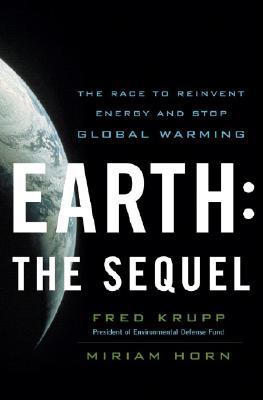

| EARTH: THE SEQUEL The Race To Reinvent Energy and Stop Global Warming Fred Krupp Miriam Horn New York: W. W. Norton & Co., 2008 |
Rating: 5.0 High |
|||
| ISBN-13 978-0-393-06690-6 | ||||
| ISBN-10 0-393-06690-8 | 279p. | HC | $24.95 | |
"Two months after the [1977 sulfur-dioxide cap and trade] law was passed, Richard Clark, then CEO of Pacific Gas & Electric, America's largest publicly owned utility, sat next to Fred Krupp at a dinner for the President's Commission on Environmental Quality. 'When you were talking to the president about this cap-and-trade idea, I frankly thought you'd lost it,' he said to Fred. 'But now that there's a way to make money from cutting pollution, I have a dozen proposals for emissions reductions from my own employees on the shop floor, and a dozen more from outside consultants. The environment isn't just a money loser—it's a profit center. I have to admit it's a powerful law." – Page 6 |
Quite right — and so it has proved to be. As the authors note on page 6, U.S. utilities cut emissions 30 percent more than the law required by 1982, even while generating 6.8 percent more electricity from coal and reducing prices on retail electricity. It also disproved the forecasts of economic ruin that appeared beforehand. The projected cost of $6 billion turned out to be between $1.1 and $1.8 billion.
Herculano Porto is a farmer in the rain forest of Brazil's vast Amazon River watershed. He (with a lot of help) has been fighting the short-sighted greed that is destroying that rain forest to the tune of 5 million acres per year. The authors note on page 193 that killing this forest "is like opening Pandora's box—releasing all manner of misery upon the world."
Bernie Karl lives to battle recalcitrant technology, and has achieved what many experts thought impossible: keeping a baroque ice palace frozen through Alaska's mid-summer heat, and running the process on the lowest-grade geothermal power source ever tapped. Their stories (told in Chapters 9 and 7 respectively) are very different, but their triumphs are equally real, and they show us why there is reason to be hopeful that we can get greenhouse gas emissions under control.1
This book is an excellent complement to George Monbiot's Heat, which examines what might be done. The authors of Earth: The Sequel conducted extensive interviews with a host of energy entrepreneurs who are demonstrating what can be done, and their first nine chapters lay forth the current status (as of early 2008) of startups in every alternate-energy area: wind, solar PV, solar thermal, biofuels, ocean energy, geothermal, and conservation. Finally, they consider the blue-sky concepts: nuclear fusion, balloons tethered in the jet stream, even solar power stations in space.
It is a very useful, and very hopeful, survey of activities. In these pages we see people coming up with good ideas, and following through to make them real. They take Nike's motto to heart: Just do it. As an antidote to the gloom and doom promulgated by certain factions, it cannot be surpassed.
"In fact, the sheer scale of the problem is one reason our sense of alarm has given way to excitement and hope. The question is no longer just how to avert the catastrophic impacts of climate change, but which nations will produce—and export—the green technologies of the twenty-first century. A cap-and-trade system for carbon dioxide will mean billions of dollars for the innovators who figure out how to save the planet, and provide the opportunity to mobilize virtually every realm of economic activity." – Page 252 |
There are no endnotes, but sources are cited in place, as footnotes or in the text. An appendix labeled "Resources" provides a two-page list of Web sites; these include environmental organizations like Grist, mainstream media2 like the Wall Street Journal, science and technology sites, and green business news aggregators. The book is a detailed and entertaining overview of the current state of alternate-energy development in the U.S. A thorough index rounds out the book. I recommend it highly.

 To contact Chris Winter, send email to this address.
To contact Chris Winter, send email to this address.